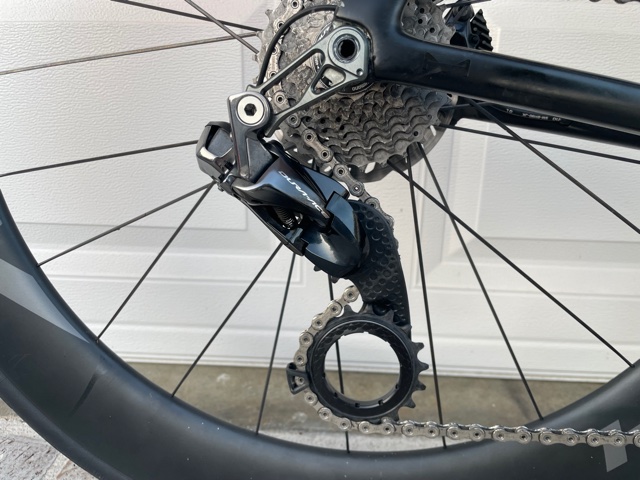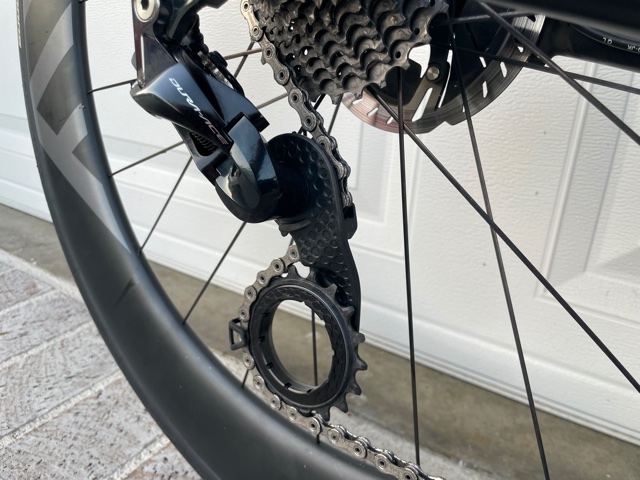naaa… im good. perfectly fine with my premier branded rear pulleys and chainring. and for a substantial difference in price, and equal performance im sure.
Fixed the title for you
.
Interesting design. Doubt this eats into any market-share for CeramicSpeed. It’s priced more towards SLF motion and probably eats into that potential market. But the design just screams chain jump.
It’s notable that they don’t list what the watt savings is. Leads one to believe that there isn’t much/any, especially since they bother to quantify less meaningful values like drivetrain noise.
The novelty in the design appears to be suspending the upper jockey in a rubber damper to make it very compliant. To ensure the jockey wheel isn’t too active within the suspension they have then set the tension of the whole system extremely low so that the derailleur itself moves under strain rather than just the jockey wheel. I can see how the low tension combined with rubber damper would reduce noise and not impact shift quality when set up perfectly out of the box. My suspicion is that things would deteriorate rapidly from there.
In terms of overall efficiency it will all come down to how much is lost by the upper wheel moving around in the elastomer due to road vibration and chain line. I am sure you could design a lab test rig which minimizes the impact of the elastomer and therefore shows a significant improvement but if you repeated the test under slightly different conditions the results would be significantly different. When it comes to both chains and freehubs the general rule is that noisy does not mean inefficient. Sound isn’t indicative of large energy losses as its friction (heat) that is really the enemy. You can make just about any chain or freehub quiet by absolutely packing it with thick grease but that doesn’t make the system faster.
I’m going to go out on a limb and guess they’re banking on sales being a result of the high price, pretty colours and mystical power of dimples. The arguments for drive train friction reduction and aerodynamic drag reduction/equivalence are just filler, to help prospective customers, attracted by the price and pretty colours, to justify the purchase to themselves and their critics.
If this product cost less than a Dura-Ace pulley set and looked pedestrian, it’s probable no-one would buy it - even if the benefit/performance claims were identical. They’re seeking credibility and desirablility via pricing and cosmetics IMO. Not a new concept, but still a frustratingly cynical one.
I agree, i wouldn’t buy either one.
It’s pretty and the price is insane.
You have to admit this is pretty compelling:
The HollowCage is "the only cage that can dynamically adapt to the variable chainline, minimising friction at the lower pulleyâ€
So it must be better!
It certainly is the better looking OSP in the market and by a good margin.
I’m no structural engineer and I wasn’t a geometry major in high school, but if I’m in the 52/11 and thus my chain is as “not straight” as it gets, the overall lateral articulation seems to be the same (i.e. the chain needs to directly underneath the 11T cog at the bottom of the upper pulley and then from there it eventually needs to move laterally to meet the chainring).
With a 100% stiff RD cage, all that articulation occurs between the bottom of the lower pulley and the chainring.
With a flexible cage, presumably some of that articulation occurs between the two pulley wheels, with the rest same as above (between the bottom of the lower pulley and the chainring).
But in each case the total lateral movement of the chain is the same, it’s just that with the stiff cage, there is a “straight” phase followed by a “crooked” phase, while with a flexible cage, you would have two “crooked” phases:
If we apply some numbers solely for the sake of example (i.e. I doubt these are “to scale”) let’s make two assumptions:
(1) Chain needs to move 12mm laterally in the 52/11
(2) Looking at the path of the chain from the bottom of the upper pulley to the chainring (the path where the chain needs to move laterally), the chain spends 1/6 of this journey “in the pulleys” (i.e. between the bottom of the upper pulley and the bottom of the lower pulley) (Phase 1) and 5/6 of its time from the bottom of the lower pulley to the chainring (Phase 2)
With a stiff cage, the chain will not move laterally during Phase 1 and will see all of its 12mm lateral movement occur during Phase 2. So 0mm deflection for Phase 1 and all 12mm deflection for Phase 2.
Assuming a perfectly flexible cage, you will have 2mm deflection for Phase 1 and the remaining 10mm deflection for Phase 2.
So really it’s a question of whether it’s better to “smooth out” the lateral deflection with a flexible cage, but at the same time increasing the duration during which the chain has to bend, or whether it’s better to keep the chain straight a bit longer (i.e. perfectly straight during Phase 1) at the expense of more lateral deflection during Phase 2.
My gut is that the flexible cage scenario is marginally better, but I question whether it’s measurable given the offsetting loss of having the chain deflect for a longer period of time.
I bought one anyways.
That looks like a cycling equivalent to a window on a PC and rainbow LED lights inside. Or a fart can exhaust and sheet metal wing riveted to the trunk.
I bought one anyways.
Please post a picture when you can…I’d like to see it
.
My gut is that the flexible cage scenario is marginally better, but I question whether it’s measurable given the offsetting loss of having the chain deflect for a longer period of time.
I bought one anyways.
The most epic, instant classic quote of slowtwitch.
Please post a picture when you can…I’d like to see it
Rode it for the first time this morning. Here is my almost entirely worthless review, and I say “almost” only because I have only one small piece of advise to offer.
Worthless Review:
No idea of installation procedure. My mechanic installed it. But he didn’t cuss at me or side eye me when I picked up my bike, so couldn’t have been that bad. No idea whether it’s aero or reduces drivetrain friction. I am of the belief that I cannot “feel” any such differences, and to be honest, I also believe no human can “feel” a difference either. Shifting is fine, I didn’t perceive any difference. Mind you, I swapped from a CeramicSpeed OSPW, not the stock cage. Sound? I swap bikes fairly often, so not uncommon that I will ride 3 different bikes in a week of 5-6 rides, and I had not ridden the bike with the Hollowcage in a couple weeks before this morning, so I can’t say I have a solid “baseline” to compare against. With that, the Hollowcage didn’t seem to intoduce any additional noise into my drivetrain, and indeed may have been quieter. Maybe we’ll see a YouTube video soon with someone measuring sound with a DB meter - I would trust that more anyways.
Unsolicited Advice:
I ordered the Hollowcage for my SystemSix, which is all black. So I chose the black lockring option. If I had to do it over again, I would choose the rainbow option or if on another bike, a color that complements that bike’s paint. The black is rather “meh” IMHO. See for yourself, with the caveat that beauty is in the eye of the beholder f course:


Thanks for sharing, I think it looks great!
Awesome and look forward to hearing more.
I’ve had a number of AbsoluteBlack products since 2015 and have been impressed. Zero issues.
Can’t speak to the Absolute Black one, but i’ve used bother Ceramic Speed and a $40 knock off from Aliexpress and they perform the same.
Do you have some sort of bench test setup? No one (absolutely zero) can feel the marginal gains of these things.
It would be interesting to know how much savings for OSPW comes from the larger pulleys and how much from the ceramic bearings. I’m guessing the lion’s share is the larger diameter pulleys, which is why an Ali Express version (with lower quality bearings than CS) still performs well.